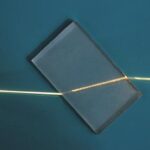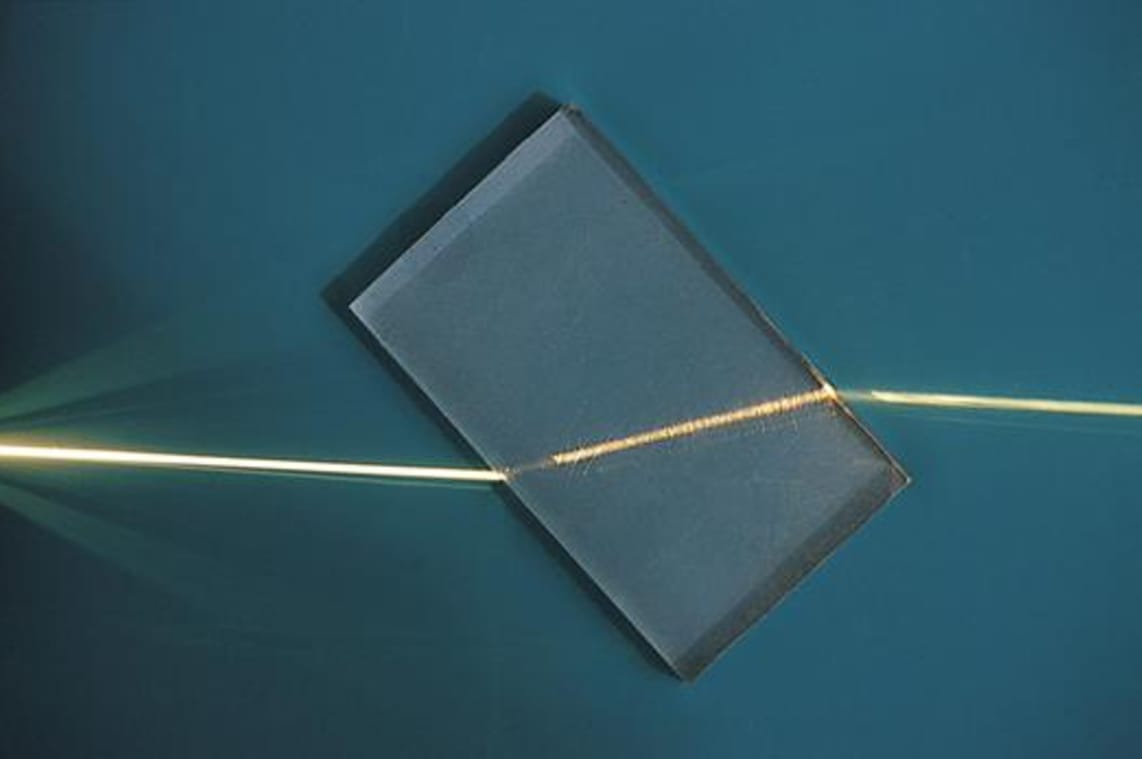*** Medium of light ** ( प्रकाश का माध्यम)
The material through which light can propagate or tries to do so, called Medium of Light. Eg. Air, water,wood etc
(वह पदार्थ जिसके माध्यम से प्रकाश गमन कर सकता है या ऐसा करने का प्रयास करता है, प्रकाश का माध्यम कहलाता है।जैसे- हवा, पानी, लकड़ी आदि)
***Types of Medium(माध्यम के प्रकार)***
There are three types of media of light.
(प्रकाश के माध्यम तीन प्रकार के होते हैं।)
(i) Transparent :- The medium through which light propagates easily called transparent medium. Ex – air, water, vacuum, glass etc
(पारदर्शी माध्यम:- जिस माध्यम से प्रकाश आसानी से गमन करता है, उसे पारदर्शी माध्यम कहा जाता है। जैसे – वायु, जल, निर्वात, कांच आदि।)
(ii) Translucent:- The medium of light through which light propagates partially, called translucent medium. Eg- oily paper, black glass etc.
(पारभासी:- प्रकाश का वह माध्यम जिससे प्रकाश आंशिक रूप से गमन करता है, पारभासी माध्यम कहलाता है। जैसे- तैलीय कागज, काला कांच आदि।)
(iii) Opaque Objects:- The objects through which light doesn’t pass, called Opaque objects. Eg. wood, iron, etc.
(अपारदर्शी वस्तुएँ:- वे वस्तुएँ जिनसे होकर प्रकाश नहीं गुज़रता, अपारदर्शी वस्तुएँ कहलाती हैं। जैसे. लकड़ी, लोहा, आदि)
Note :- All the transparent media vacuum, air, water and glasses have been classified into two types.
(सभी पारदर्शी माध्यमों निर्वात, वायु, जल एवं काँच को दो प्रकारों में वर्गीकृत किया गया है।)
i) Optically Rarer or Rarer medium
( प्रकाशतः विरल या विरल माध्यम)
ii) Optically denser or Denser Medium (प्रकाशतः सघन या सघन माध्यम)
***Optically Rarer ***
(विरल माध्यम)
The medium of light in which the speed of light is more , is called the Rarer medium.
(प्रकाश का वह माध्यम जिसमें प्रकाश की गति अधिक होती है, विरल माध्यम कहलाता है।)
*** Optically Denser ***
(सघन माध्यम)
The medium of light in which the speed of light is less , is called Denser medium.
( प्रकाश का वह माध्यम जिसमें प्रकाश की गति कम होती है, सघन माध्यम कहलाता है।)
Eg :- In air and water, the air is rarer and water is denser.
(हवा और पानी में, हवा विरल है और पानी सघन है।)
*** Refraction of Light ***
(प्रकाश का अपवर्तन)
When a ray of light passes from one medium to another medium the Ray propagates by changing its original path into the second medium, this phenomenon is called Refraction of light.
(जब प्रकाश की किरण एक माध्यम से दूसरे माध्यम में जाती है तो दूसरे माध्यम में किरण अपने निश्चित पथ से विचलित हो जाती है, इस घटना को प्रकाश का अपवर्तन कहा जाता है।)
Another Definition (दूसरी परिभाषा)
When a ray of light passes from denser to rarer, the Ray propagates by bending away from the normal, And when the Ray passes from rarer to denser, the Ray propagates by bending towards the normal, this phenomenon is called Refraction of light.
(जब प्रकाश की किरण सघन से विरल की ओर जाती है, तो किरण अभिलम्ब से दूर होकर गमन करती है, और जब किरण विरल से सघन की ओर जाती है, तो किरण अभिलम्ब की ओर झुककर गमन करती है, इस घटना को प्रकाश का अपवर्तन कहा जाता है।)
*** Terms Related to Refraction of light ***
(प्रकाश के परावर्तन से जुड़े कुछ शब्द)
(i) Incident ray:- The Ray which falls on the boundary of two different media, called Incident Ray.
(आपतित किरण:- वह किरण जो दो भिन्न माध्यमों की सीमा पर पड़ती है, आपतित किरण कहलाती है।)
(ii) Point of incidence:- The point at the boundary of two different media where incident Ray falls, called the point of incidence.
(आपतन बिन्दु:- दो भिन्न माध्यमों की सीमा पर स्थित वह बिन्दु जहाँ पर आपतित किरण पड़ती है, आपतन बिन्दु कहलाता है।)
(iii) Normal:- The perpendicular drawn at the point of incidence to the boundary of the separating medium, is called Normal.
(अभिलम्ब:- आपतन बिंदु पर पृथक्करण माध्यम की सीमा पर खींचा गया लंब, अभिलम्ब कहलाता है।)
(iv) Refracted ray:- The Ray in the second medium which propagates by deflecting from its original path is called Refracted Ray.
(अपवर्तित किरण :-दूसरे माध्यम में वह किरण जो अपने मूल पथ से विक्षेपित होकर गमन करती है, अपवर्तित किरण कहलाती है।)
(v) Angle of incidence:- The angle between incident ray and normal is called the angle of incidence.
Note :- it is denoted by ∠i.
(आपतन कोण:– आपतित किरण और अभिलम्ब के बीच के कोण को आपतन कोण कहते हैं।)
Note:- इसे ∠i द्वारा दर्शाया जाता है।
(vi) Angle of refraction:- The angle between Refracted ray and normal is called the angle of Refraction.
Note:- it is denoted by ∠r.
(अपवर्तन कोण:- अपवर्तित किरण और अभिलम्ब के बीच के कोण को अपवर्तन कोण कहा जाता है।)
Note :- इसे ∠r से दर्शाया जाता है।
**** Laws of Refraction***
(अपवर्तन के नियम)
(i) Incident Ray, normal and refracted ray lie on the same point on the boundary.
( आपतित किरण, अभिलम्ब और अपवर्तित किरणें सीमा पर एक ही बिंदु पर स्थित होती हैं।)
(ii) The ratio of sine of angle of incidence and sine of angle of refraction is always constant.
i.e Sin∠i / Sin∠r = constant = μ
(आपतन कोण की ज्या और अपवर्तन कोण की ज्या का अनुपात सदैव स्थिर रहता है।)
Sin∠i / Sin∠r = constant = μ
Note :- This law is called Snell’s law because it was given by Snell.
(इस नियम को स्नेल का नियम कहा जाता है क्योंकि यह स्नेल द्वारा दिया गया था।)
Note :- This constant is called refractive index.
(इस स्थिरांक को अपवर्तनांक कहा जाता है।)
(iii) When a ray of light passes from one medium to another , it doesn’t change its frequency but it changes its wavelength and speed.
(जब प्रकाश की किरण एक माध्यम से दूसरे माध्यम में जाती है तो उसकी आवृत्ति में कोई परिवर्तन नहीं होता, परंतु उसकी तरंगदैर्घ्य और गति में परिवर्तन होता है।)
*** Refraction through rectangular Glass slab***
(आयताकार काँच की सिल्ली से अपवर्तन)
When an incident ray passes through a rectangular glass slab, The refraction occurs two times, after the first refraction, The ray is called refracted ray and after the second refraction, The ray is called emergent ray. In this case emergent ray and incident ray are parallel to one another.
(जब एक आपतित किरण एक आयताकार कांच के स्लैब से होकर गुजरती है, तो अपवर्तन दो बार होता है, पहले अपवर्तन के बाद, किरण को अपवर्तित किरण कहा जाता है और दूसरे अपवर्तन के बाद, किरण को निर्गत किरण कहा जाता है। इस मामले में निर्गत किरण और आपतित किरण एक दूसरे के समानांतर होती हैं।)
Note:- Angle of emergence:- The angle between emergent ray and normal called angle of emergence.
It is denoted by ∠e
(निर्गत कोण:- निर्गत किरण और अभिलंब के बीच के कोण को निर्गत कोण कहते हैं।
इसे ∠e से दर्शाया जाता है)
Note:- Lateral Displacement/shift :- When a ray of light passes through a rectangular Glass slab, the incident ray and emergent ray becomes parallel to each other. The perpendicular distance between emergent ray and incident ray, is called Lateral displacement.
(पार्श्व विस्थापन:- जब प्रकाश की किरण एक आयताकार कांच की स्लैब से होकर गुजरती है, तो आपतित किरण और निर्गत किरण एक दूसरे के समानांतर हो जाती हैं। निर्गत किरण और आपतित किरण के बीच लंबवत दूरी को पार्श्व विस्थापन कहते हैं।)
*** Refractive Index ***
(अपवर्तनांक)
Refractive index of the second medium is defined as the ratio between the speed of light in the first medium and the speed of light in the second medium.
(किसी दूसरे माध्यम का अपवर्तनांक, पहले माध्यम में प्रकाश की गति और दूसरे माध्यम में प्रकाश की गति के बीच के अनुपात को कहा जाता है।)
Note:- it is denoted by μ21 or n21.
(इसे μ21 या n21 द्वारा दर्शाया जाता है|)
Note:- it is a ratio quantity that’s why it is unitless.
(यह एक अनुपात है इसलिए यह इकाई रहित है।)
Note:- μ21 is read as the refractive index of the second medium with respect to the first medium.
(μ21 को प्रथम माध्यम के सापेक्ष दूसरे माध्यम के अपवर्तनांक के रूप में पढ़ा जाता है।)
μ21= speed of light in the first medium/speed of light in
the second medium
Note:- Refractive Index tell us in which medium speed of light is more or less.
(अपवर्तनांक हमें बताता है कि किस माध्यम में प्रकाश की गति अधिक या कम होती है।)
Note:– If the refractive index of any medium is more than the speed of light will be less in that medium, If the refractive index of any medium is less than the speed of light will be more in that medium.
(यदि किसी माध्यम का अपवर्तनांक अधिक है तो उस माध्यम में प्रकाश की गति कम होगी। यदि किसी माध्यम का अपवर्तनांक कम है तो उस माध्यम में प्रकाश की गति अधिक होगी।)
Note :- Refractive index of any medium is also defined as the bending ability of light in any Medium.(किसी भी माध्यम के अपवर्तनांक को किसी भी माध्यम में प्रकाश की झुकने की क्षमता के रूप में भी परिभाषित किया जाता है।)
Note:- If the refractive index is more then the Ray of light will bend more and if the refractive index is less then the Ray of light will bend less.
(यदि अपवर्तनांक अधिक है तो प्रकाश की किरण अधिक मुड़ेगी और यदि अपवर्तनांक कम है तो प्रकाश की किरण कम मुड़ेगी।)
Note:- If the refractive index is more then the medium will be denser and the refractive index is less then the medium will be rarer.(यदि अपवर्तनांक अधिक है तो माध्यम सघन होगा तथा यदि अपवर्तनांक कम है तो माध्यम विरल होगा।)
Q. Find the speed of light in diamond? If the refrative index of Diamond is 2.42
*** Definition of Refractive Index given by Snell’s ****
The refractive index of the second medium is defined as the ratio between sine of angle of incidence and sine of angle of refraction.
(दूसरे माध्यम का अपवर्तनांक आपतन कोण की ज्या और अपवर्तन कोण की ज्या के बीच का अनुपात होता है।)
i.e
μ21 = Sin i / Sin r
*** Absolute Refractive index ***
(निरपेक्ष अपवर्तनांक)
The refractive index of any medium with respect to air or vacuum is called Absolute Refractive Index.
(वायु या निर्वात के संबंध में किसी भी माध्यम के अपवर्तनांक को निरपेक्ष अपवर्तनांक कहा जाता है।)
Note :- it is denoted by μ1 or aμ1
Q Find absolute Refractive index of air.
Ans – 1
*** Relative Refractive Index ***
(सापेक्ष अपवर्तनांक)
Relative refractive index of any medium is defined as the ratio between absolute refractive index of second medium and absolute refractive index of first medium.
(किसी भी दूसरे माध्यम के निरपेक्ष अपवर्तनांक तथा पहले माध्यम के निरपेक्ष अपवर्तनांक के बीच के अनुपात को दूसरे माध्यम का सापेक्ष अपवर्तनांक कहा जाता है।)
R.R.I = μ1 / μ 2
{Speed of light in air(C)} /{ speed of light in the second
medium (C2)}
= ——————————————–
{Speed of light in air(C)}/ { speed of light in the first
medium (C1)}
= ( C / C2) × (C1 / C)
= C1 / C2
{speed of light in the first medium
(C1)}
=———————————————
{ speed of light in the second
medium (C2)}
Note :- The Relative Refractive index is also defined as the ratio between the speed of light in the first medium and the speed of light in the second medium.
(सापेक्ष अपवर्तनांक को प्रथम माध्यम में प्रकाश की गति तथा दूसरे माध्यम में प्रकाश की गति के बीच के अनुपात के रूप में भी परिभाषित किया जाता है।)
*** Principle of Reversibility of Light**
(प्रकाश की उत्क्रमणीयता का सिद्धांत)
According to the principle of reversibility of light, the path of light is reversible i.e the refractive index of the second medium with respect to the first is the reciprocal of the refractive index of the first medium with respect to the second.
(प्रकाश की उत्क्रमणीयता के सिद्धांत के अनुसार, प्रकाश का पथ उत्क्रमणीय होता है, अर्थात् प्रथम माध्यम के सापेक्ष दूसरे माध्यम का अपवर्तनांक, दूसरे माध्यम के सापेक्ष प्रथम माध्यम का अपवर्तनांक एक दूसरे का व्युत्क्रम होता है।)
i.e μ21 = C1 / C2 ———-(i)
=> μ12 = C2 / C1
=> 1 / μ12 = C1 / C2
From equation (i) we have
=> μ21 = 1 / μ12
*** Proof of Angle of incidence equal to the Angle of Emergence When a ray of light passes through rectangular Glass slab****
(जब प्रकाश की किरण आयताकार काँच की सिल्ली से गुजरती है तो आपतन कोण और निर्गत कोण बराबर होते है, का प्रमाण)
∠BHC = ∠BGC (90⁰)
∵ PQ ∥ RS
and BH ⊥ PQ or SR
And CG ⊥ PQ or SR
Hence BH ∥ CG & BC acts as a transversal
∴ ∠HBC = ∠BCG
⇒ ∠r1 = ∠r2
Now, from Snell’s law
μga=Sin∠i / Sin∠r1 ——– —(i)
& μga= Sin∠r2 / Sin∠e ———–(ii)
From the principle or Reversibility of light
μga = 1/μga
⇒Sin∠i / Sin∠r1= Sin∠e / Sin∠r1
⇒Sin∠i = Sin∠e
⇒∠i = ∠e
Hence we can say that angle of incidence and angle of emergence are equal when the Ray of light passes through rectangular Glass slab.(अतः हम कह सकते हैं कि जब प्रकाश की किरण आयताकार कांच की पट्टी से गुजरती है तो आपतन कोण और निर्गत कोण बराबर होते हैं।)
*** Factor Affecting Refractive index of any medium***
(किसी भी माध्यम के अपवर्तनांक को प्रभावित करने वाला कारक)
(i) Nature Of medium:- The medium in which speed of light is more will have less refractive index. Whereas the medium in which less speed of light will have more refractive index.
(पदार्थ की प्रकृति:- जिस माध्यम में प्रकाश की गति अधिक होगी उस माध्यम का अपवर्तनांक कम होगा। जबकि जिस माध्यम में प्रकाश की गति कम होगी उस माध्यम का अपवर्तनांक अधिक होगा।)
(ii) Temperature:- On increasing the temperature of any medium, the speed of light increases, due to which the refractive index of that medium decreases.
( तापमान:- किसी भी माध्यम का तापमान बढ़ाने पर प्रकाश की गति बढ़ जाती है, जिस कारण उस माध्यम का अपवर्तनांक कम हो जाता है|)
(iii) Wavelength of light:- We know that the different colours of light have different wavelengths. The colour whose wavelength is more will have less Refractive index of that medium. And the colour whose wavelength is less will have more Refractive index of that medium.
(हम जानते हैं कि प्रकाश के विभिन्न रंगों की तरंगदैर्घ्य अलग-अलग होती है। जिस रंग की तरंगदैर्घ्य अधिक होगी, उस माध्यम का अपवर्तनांक कम होगा। तथा जिस रंग की तरंगदैर्घ्य कम होगी, उस माध्यम का अपवर्तनांक अधिक होगा।)
Eg:- Violet has less wavelength so it has high refractive index whereas red has more wavelength it has less Refractive index.
(बैंगनी रंग की तरंगदैर्घ्य कम होती है इसलिए इसका अपवर्तनांक अधिक होता है जबकि लाल रंग की तरंगदैर्घ्य अधिक होने के कारण इसका अपवर्तनांक कम होता है।)
*** Lens***(लेंस)
The transparent medium whose at least one part is curved is called a lens.
(वह पारदर्शी माध्यम जिसका कम से कम एक भाग वक्राकार हो, लेंस कहलाता है।)
*** Types of lens***(लेंस के प्रकार)
There are mainly two types of lens. (लेंस मुख्यतः दो प्रकार के होते हैं।)
(i) Convex lens or Converging lens(उत्तल लेंस या अभिसारी लेंस)
(ii) Concave lens of Diverging lens(अवतल लेंस या अपसारी लेंस)
Types of convex lens
Note :- Biconvex is also called Equiconvex.
Types of concave lens
Note:- Biconcave is also called Equiconcave.
*** Convex lens***(उत्तल लेंस)
A lens which is thicker at the centre but thinner at the edges is called a convex lens.
(वह लेंस जो बीच में मोटा परन्तु किनारों पर पतला होता है, उत्तल लेंस कहलाता है।)
****Concave lens***(अवतल लेंस)
A lens which is thicker at the edges but thinner at the centre is called a concave lens.
(वह लेंस जो किनारों पर मोटा लेकिन बीच में पतला होता है, अवतल लेंस कहलाता है।)
*** Terms Related to lens***
(लेंस से संबंधित शब्द)
(i) Centre of curvature:- The centre of a spherical lens of which the lens is made up of is called centre of curvature.
(वक्रता केन्द्र:- किसी गोलाकार लेंस का वह केन्द्र जिससे लेंस बना होता है, वक्रता केन्द्र कहलाता है।)
Note:- It is denoted by ‘C'(इसे ‘C’ से दर्शाया जाता है।)
Note:- A Lens has two centre of curvature.(एक लेंस के दो वक्रता केंद्र होते हैं।)
(ii) Principal axis or Main Axis
(प्रधान अक्ष या मुख्य अक्ष)
The imaginary line that joins both the centre of curvature and goes both the side to infinity is called principal axis.
(प्रधान अक्ष या मुख्य अक्ष :- वह काल्पनिक रेखा जो वक्रता केन्द्र को मिलाती है तथा दोनों ओर से अनन्त तक जाती है, मुख्य अक्ष कहलाती है।)
(iii) Radius of curvature:- The distance between the centre of the curvature and the periphery of the lens is called the Radius of the curvature.
(वक्रता त्रिज्या:- वक्रता केन्द्र और लेंस की वक्रता के बीच की दूरी को वक्रता त्रिज्या कहते हैं।)
Note:- it is denoted by R.(इसे R से दर्शाया जाता है।)
(iv) Optical centre:- ( for thin lena)
A point inside the lens at which the ray Falls then the Ray passes through the lens without any deviation is called optical centre.
(लेंस के अंदर वह बिंदु जिस पर किरण पड़ती है और फिर किरण बिना किसी विचलन के लेंस से गुजर जाती है, प्रकाशिक केंद्र कहलाता है।)
(For thick lens)
A point inside the lens through which the ray passes then emergent Ray becomes parallel to incident ray, the point is called optical centre.
(लेंस के अंदर वह बिंदु जिससे होकर किरण गुजरती है और फिर निर्गत किरण आपतित किरण के समानांतर हो जाती है, उस बिंदु को प्रकाशिक केंद्र कहा जाता है।)
(V) Focus or Main focus
When parallel rays to the principal Axis fall on the lens after refraction all the refracted rays meet or appear to meet at a point on the principal axis, this point is called Focus.
(फोकस:- जब मुख्य अक्ष के समान्तर किरणें लेंस पर पड़ती हैं तो अपवर्तन के बाद सभी अपवर्तित किरणें मुख्य अक्ष पर एक बिंदु पर मिलती हैं या मिलती हुई प्रतीत होती हैं, इस बिंदु को फोकस कहा जाता है।)
Note:- there are two principal foci in the lens.
(i) First principal focus(F1)
(ii) Second principal focus(F2)
(vi) Focal length:- The distance between focus and optical centre is called focal length.
(फोकस दूरी या फोकसांतर:- फोकस और प्रकाशिक केंद्र के बीच की दूरी को फोकस दूरी या फोकसांतर लंबाई कहा जाता है।)
Note:- it is denoted by f.
(इसे f से दर्शाया जाता है।)
(vii) Aperture :- The breadth of a lens is called aperture.
(एपर्चर या द्वारक :- लेंस की चौड़ाई को एपर्चर या द्वारक कहा जाता है।)
(viii) Focal plane :- The plane which passes through focus and perpendicular to the principal axis is called focal plane.
(फोकल समतल:- वह तल जो फोकस से होकर गुजरता है तथा मुख्य अक्ष के लंबवत होता है, फोकल तल या समतल कहलाता है।
*** Ray movement through lens***
(लेंस के लिए किरण आरेख की बनावट)
(i) When a ray parallel to the principal axis falls on the lens, the refracted ray passes or appears to pass through focus.
(जब मुख्य अक्ष के समांतर कोई किरण लेंस पर पड़ती है, तो अपवर्तित किरण फोकस से होकर गुजरती है या गुजरती हुई प्रतीत होती है।)
(ii) When a ray passes or appears to pass through focus, the refracted ray becomes parallel to the principal axis.
(जब कोई किरण फोकस से गुजरती है या गुजरती हुई प्रतीत होती है, तो अपवर्तित किरण मुख्य अक्ष के समानांतर हो जाती है|)
(iii) When a ray passes through the optical centre, the refracted ray propagates on a straight path without any deviation.
(जब कोई किरण प्रकाशीय केंद्र से होकर गुजरती है, तो अपवर्तित किरण बिना किसी विचलन के सीधे पथ पर गमन करती है।)
*** Image formation by convex lens****
(उत्तल लेंस द्वारा प्रतिबिम्ब का बनना)
(i) When the object is at infinity.
Position of image:- At Focus
(प्रतिबिम्ब की स्थिति)
Nature of image :- real and inverted
(प्रतिबिम्ब की प्रकृति)
Size of image :- very-very small
(प्रतिबिम्ब का आकार)
(ii) When an object is between infinity and 2F1
Position of image:- between F2 and
(प्रतिबिम्ब की स्थिति) 2F2
Nature of image :- real and inverted
(प्रतिबिम्ब की प्रकृति)
Size of image :- smaller than the
(प्रतिबिम्ब का आकार) object.
(iii) When an object is at 2F1
Position of image:- At 2F2
(प्रतिबिम्ब की स्थिति)
Nature of image :- real and inverted
(प्रतिबिम्ब की प्रकृति)
Size of image :- same as the object
(प्रतिबिम्ब का आकार)
(iv) When an object is between 2F1 and F1
Position of image:- between 2F2 &
(प्रतिबिम्ब की स्थिति) Infinity
Nature of image :- real and inverted
(प्रतिबिम्ब की प्रकृति)
Size of image :- larger than the
(प्रतिबिम्ब का आकार) object
(v) When an object is at F1
Position of image:- at Infinity
(प्रतिबिम्ब की स्थिति)
Nature of image :- real and inverted
(प्रतिबिम्ब की प्रकृति)
Size of image :- very larger than the
(प्रतिबिम्ब का आकार) object
(vi) When object is between F1 and optical centre
Position of image:- same side of the
(प्रतिबिम्ब की स्थिति) object
Nature of image :- virtual and erect
(प्रतिबिम्ब की प्रकृति)
Size of image:- larger than object
(प्रतिबिम्ब का आकार)
*** Image formation by concave lens***
(अवतल लेंस द्वारा प्रतिबिम्ब निर्माण)
(i) When the object is at infinity
Position of image:- At focus
(प्रतिबिम्ब की स्थिति)
Nature of image :- virtual and erect
(प्रतिबिम्ब की प्रकृति)
Size of image:- very smaller than
(प्रतिबिम्ब का आकार) object
(ii) When the object is between infinity and optical centre
Position of image:- same side of the
(प्रतिबिम्ब की स्थिति) Object b/w F & O
Nature of image :- virtual and erect
(प्रतिबिम्ब की प्रकृति)
Size of image:-smaller than object
(प्रतिबिम्ब का आकार)
**** The direction of bending of light ***
(i) When ray passes from Rarer to denser medium.
(जब किरण विरल माध्यम से सघन माध्यम में गुजरती है)
According to Snell’s law
स्नेल के नियम के अनुसार
μDR = Sin∠i / Sin∠r ——(i)
Speed of light in rarer (C1)
μDR = ——————————
Speed of light in denser (C2)
μDR = C1/ C2 ———— (ii)
From (i) and (ii) we get
Sin∠i / Sin∠r = C1/ C2
We know that speed of light in rarer medium is greater than speed of light denser.
(हम जानते हैं कि विरल माध्यम में प्रकाश की गति सघन माध्यम में प्रकाश की गति से अधिक होती है।)
So , C1 > C2
=> C1 / C2 > 1
=> Sin∠i / Sin∠r > 1
=> Sin∠i > Sin∠r
=> ∠i > ∠r
When a ray passes from rarer to denser medium, the angle of incidence is greater than the angle of refraction, that’s why the refracted ray bends towards the normal.
(जब कोई किरण विरल माध्यम से सघन माध्यम में जाती है तो आपतन कोण अपवर्तन कोण से अधिक होता है, इसीलिए अपवर्तित किरण अभिलंब की ओर मुड़ जाती है।)
(ii) when a ray passes from denser to Rarer.
(जब एक किरण सघन से विरल की ओर जाती है)
According to Snell’s law
स्नेल के नियम के अनुसार
μRD = Sin∠i / Sin∠r ——(i)
Speed of light in denser (C1)
μRD = ——————————
Speed of light in rarer(C2)
μRD = C1/ C2 ———— (ii)
From (i) and (ii) we get
=> Sin∠i / Sin∠r = C1/ C2
We know that the speed of light in a rarer medium is greater than the speed of light denser.
(हम जानते हैं कि विरल माध्यम में प्रकाश की गति सघन माध्यम में प्रकाश की गति से अधिक होती है।)
∴ C1 < C2
=> C1 / C2 < 1
=> Sin∠i / Sin∠r < 1
=> Sin∠i < Sin∠r
=> ∠i < ∠r
So, when a ray passes from a denser to a rarer medium, the angle of refraction is greater than the angle of incidence, that’s why the ray propagates by bending away from the normal.
(जब कोई किरण सघन माध्यम से विरल माध्यम में जाती है, तो अपवर्तन कोण आपतन कोण से अधिक होता है, इसीलिए किरण अभिलम्ब से दूर मुड़कर गमन करती है।)
(III) When a ray falls perpendicular at the boundary of two media
(जब एक किरण दो माध्यमों की सीमा पर लंबवत पड़ती है)
μRD = Sin∠i / Sin∠r ——(i)
=> Sin∠i /μRD= Sin∠r
∵ ∠i = 0⁰
=> Sin 0 / μRD = Sin∠r
=> Sin∠r = 0
=> ∠r = 0⁰
When a ray falls on the interface of two media perpendicularly, the angle of incidence and angle of refraction both become zero. So no refraction occurs, and the ray propagates on a straight path.
(जब कोई किरण दो माध्यमों के लंबवत अंतरापृष्ठ पर पड़ती है, तो आपतन कोण और अपवर्तन कोण दोनों शून्य हो जाते हैं। इसलिए कोई अपवर्तन नहीं होता है, और किरण सीधे पथ पर गमन करती है।)
(iv) When both the media have same refractive index
(जब दोनों माध्यमों का अपवर्तनांक समान हो)
When two media have the same Refractive index then both have the same speed of light.
(जब दो माध्यमों का अपवर्तनांक समान होता है तो दोनों की प्रकाश की गति समान होती है।)
So,
Sin∠i / Sin∠r = C1/C2
∵ C1= C2
∴ Sin∠i / Sin∠r = 1
=> Sin∠i = Sin∠r
=> ∠i = ∠r
When two media have the same Refractive index , the angle of incidence and the angle of refraction both become equal, hence no refraction occurs and the ray of light propagates on a straight path.
(जब दो माध्यमों का अपवर्तनांक समान होता है, तो आपतन कोण और अपवर्तन कोण दोनों बराबर हो जाते हैं, इसलिए कोई अपवर्तन नहीं होता है और प्रकाश की किरण सीधे पथ पर गमन करती है।)
*** Sign convention in lenses***
(लेंस में चिन्ह परिपाटी।)
The method of using positive or negative signs before any distance measured from the optical centre of the lens is called Sign convention in lenses.
(लेंस के प्रकाशिक केंद्र से मापी गई किसी भी दूरी से पहले धनात्मक या ऋणात्मक चिह्नों का उपयोग करने की विधि को लेंस में चिह्न परिपाटी कहा जाता है।)
*** Rules For sign convention in lenses***
(लेंस में चिन्ह परिपाटी के नियम)
(i) Principal axis is considered as x -axis and optical centre is considered as origin.
( प्रधान अक्ष को x-अक्ष तथा प्रकाशिय केन्द्र को मूल बिन्दु माना जाता है।)
(ii) Distance is always measured from the optical centre.
(दूरी हमेशा प्रकाशिय केन्द्र से मापी जाती है।)
(iii) If The direction of the distance measured is the same as the direction of the incident ray then the distance is taken positive.
(यदि मापी गई दूरी की दिशा आपतित किरण की दिशा के समान है तो दूरी को धनात्मक लिया जाता है।)
(iv) If The direction of the distance measured is the opposite to the direction of the incident ray then the distance is taken negative.
(यदि मापी गई दूरी की दिशा आपतित किरण की दिशा के विपरीत है तो दूरी ऋणात्मक ली जाती है।)
(v) The distance measured above the principal axis is taken positive.
(मुख्य अक्ष के ऊपर मापी गई दूरी को धनात्मक लिया जाता है।)
(vi) The distance measured below the principal axis is taken negative.
(मुख्य अक्ष के नीचे मापी गई दूरी ऋणात्मक ली जाती है।)
*** Sign Convention in convex lens***
(उत्तल लेंस में चिन्ह परिपाटी।)
| Distance | Symbol | Sign |
| Object distance | u | – |
| Focal length | f | + |
Image distance | v | (-)For virtual,(+) For real |
| Double focal length | 2f | + |
****Sign Convention in concave Lens***
(अवतल लेंस में चिन्ह परिपाटी)
| Distance | Symbol | Sign |
| Object distance | u | – |
| Focal length | f | – |
| Image distance | v | (-)For virtual |
| Double focal length | 2f | – |
*** Lens formula***
(लेंस सूत्र)
1/v – 1/u = 1/f
*** Lens formula in convex lens***
(उत्तल लेंस में लेंस सूत्र)
In △AOB and △A’OB’
∠AOB = ∠A’OB’ (VOA)
∠ABO = ∠A’ B’O ( 90⁰)
By AA similarity
△AOB ∼ △A’OB’
AB/A’B’ = OB/OB’ _____(i)
In △DOF2 and △A’B’F2
∠D F2O = ∠A’F2B’ (VOA)
∠DOF2 = ∠A’B’F2 ( 90⁰)
By AA similarity
△DOF2 ∼ △A’B’F2
DO/ A’B’ = OF2 / B’F2
=>AB/A’B’ = OF2 / (OB’-OF2) [ FROM FIGURE ] ______(ii)
From (i) and (ii), we get
OB/OB’ = OF2 / (OB’-OF2)
By using sign convention in convex lens (उत्तल लेंस में चिन्ह परिपाटी का उपयोग करके)
(-u)/ v = f / (v- f)
=> -u (v- f) = f (v)
=> – uv +uf = vf
Divide by uvf both the side
=> -1/f + 1/v = 1/u
=> 1/v – 1/u = 1/f proved
*** Lens Formula in concave lens***
(अवतल लेंस में लेंस सूत्र)
In △AOB and △A’OB’
∠AOB = ∠A’OB’ (common)
∠BAO = ∠B’A’O (90⁰)
By AA similarity
△AOB ∼ △A’OB’
=> AB/A’B’ = OA/OA’ _____(i)
In △COF1 and △B’A’F1
∠CF1O = ∠A’F1B’ (common)
∠COF1 = ∠B’A’F1 (90⁰)
By AA similarity
In △COF1 ∼ △B’A’F1
=> CO/ A’B’ = OF1/ A’F1
=> AB/ A’B’ = OF1/ (OF1– OA’) [from figure) ___________(ii)
from (i) and (ii) we get
OA/OA’ = OF1/ (OF1– OA’)
By using sign convention in concave lens ( अवतल लेंस में चिन्ह परिपाटी का उपयोग करके)
=> -u/-v = -f / {-f – (-v)}
=> u/v = -f / {-f + v}
=> u ( – f + v) = -vf
=> -fu + uv = – vf
Divide by uvf both the sides we get
=> – 1/v + 1/f = – 1/u
=> 1/v – 1/u = 1/f proved
*** Linear Magnification or Magnification in lens***
(रैखिक आवर्धन या आवर्धन क्षमता)
The ratio between height of image and height of object is called Magnification of lens.
(प्रतिबिम्ब की ऊंचाई और वस्तु की ऊंचाई के बीच के अनुपात को लेंस का आवर्धन कहा जाता है।)
Note:- it is denoted by ‘m’.
(इसे m से दर्शाया जाता है)
Note:- m = (hi/ ho)
Note:- It is a ratio quantity because it has only numerical value.(यह एक अनुपात है क्योंकि इसका केवल संख्यात्मक मान होता है।)
Note:- It is a unitless physical quantity.(यह एक इकाई रहित भौतिक राशि है।)
Note:- Magnification tells us how many times the height of the image is greater or smaller than the height of the object.
(आवर्धन हमें बताता है कि प्रतिबिम्ब की ऊंचाई वस्तु की ऊंचाई से कितनी गुणा अधिक या कम है।)
Note:- Another formula for magnification. (आवर्धन के लिए और सूत्र)
(i) m = (v/u)
(ii) m = (f-v) / f
(iii) hi/ho = (v/u)
Note:- If Magnification becomes positive of any object then the nature of the image will be virtual and erect in the mirror.
(यदि किसी वस्तु का आवर्धन धनात्मक हो जाए तो दर्पण में प्रतिबिम्ब की प्रकृति आभासी एवं सीधी होगी।)
Note:- If Magnification comes negative of any object then the nature of the image will be real and inverted in the mirror.
(यदि किसी वस्तु का आवर्धन ऋणात्मक हो तो दर्पण में प्रतिबिम्ब की प्रकृति वास्तविक एवं उल्टी होगी।)
*** Power of lens**
(लेंस की शक्ति/ क्षमता)
The reciprocal of the focal length of any lens is called Power of lens.
(किसी भी लेंस की फोकस दूरी के व्युत्क्रम को लेंस की शक्ति कहते हैं।)
Or
The ability of converging or diverging of light of any lens is called Power of a lens.
(किसी भी लेंस की प्रकाश को अभिसारी या अपसारी करने की क्षमता को लेंस की शक्ति कहते हैं।)
Note:- It is denoted by ‘P’.
(इसे ‘P’ से दर्शाया जाता है।)
Note:- P = 1/f
Note:- The SI unit of power of lens m-1 and diopter ( D). (लेंस की शक्ति का SI मात्रक m-1 और डायोप्टर (D) है।
Note:- If Power is positive then the lens will be a convex lens and if the Power is negative then the lens will be a concave lens.
(यदि पावर धनात्मक है तो लेंस उत्तल लेंस होगा और यदि पावर ऋणात्मक है तो लेंस अवतल लेंस होगा।)
Note :- P ∝ 1/f
*** Combination of Power of lenses***
(लेंस की शक्ति का संयोजन)
The combination of Power of lenses is an algebraic sum of all the power of given lenses.
(लेंस की शक्ति का संयोजन दिए गए लेंस की सभी शक्तियों का बीजगणितीय योग है।)
Note :- It is denoted by Pequ
Note:- Pequ = P1 + P2 + P3 + …..+ Pn
Note:- When we find the sum of the power of lenses, we must use sign convention.









